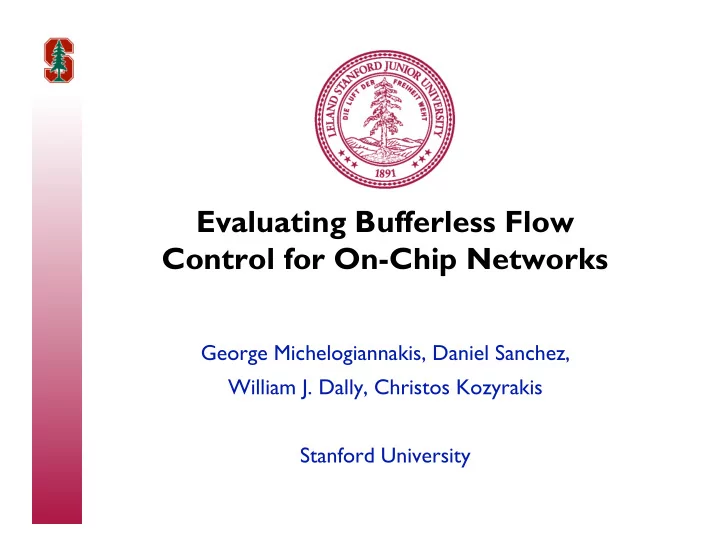

Evaluating Bufferless Flow Control for On-Chip Networks George Michelogiannakis, Daniel Sanchez, William J. Dally, Christos Kozyrakis Stanford University
In a nutshell � � Many researchers report high buffer costs. � � Motivates bufferless networks. � � We compare bufferless networks with VC networks. � � We perform simple optimizations on both sides and a thorough analysis. � � We show that bufferless networks: • � Consume only marginally less energy than buffered networks at very low loads. • � Have higher latency and provide less throughput per unit power. • � Are more complex. �
Outline � � Methodology. • � Evaluation infrastructure. � � Background. � � Optimizing routing in BLESS. � � Router microarchitecture. � � Network evaluation. � � Discussion. � � Conclusion. �
Methodology � � Cycle-accurate network simulator. � � Balfour and Dally [ICS ‘06] power and area models. • � Based on first-order principles. • � We validate our models against HSPICE. � � 32nm ITRS high performance models, as a worst case for leakage power. • � Also, a 45nm low-power commercial library. � � 2D 8x8 mesh. �
Outline � � Methodology. � � Background. • � A quick overview. � � Optimizing routing in BLESS. � � Router microarchitecture. � � Network evaluation. � � Discussion. � � Conclusion. �
Bufferless flow control � � Flits can’t wait in routers. � � Contention is handled Ouch by: • � Dropping and retransmitting from the source. • � Deflecting to a free output. �
BLESS deflection network [ISCA ’09] � � Flits bid for a single output using dimension-ordered routing (DOR). � � Body flits may get deflected. • � They must contain destination information. • � They may arrive out of order. � � Oldest flits are prioritized to avoid livelocks. � � We compare virtual channel (VC) networks against BLESS. �
Outline � � Methodology. � � Background. � � Optimizing routing in BLESS. • � Dimension-order revisited. � � Router microarchitecture. • � Implications in router design. � � Network evaluation. � � Discussion. � � Conclusion. �
Optimizing routing in BLESS � � Deadlocks impossible in bufferless networks, thus DOR unnecessary. � � Multidimensional routing (MDR) requests all productive outputs. � � 5% lower latency, equal throughput compared to DOR. �
Allocator complexity � � Deflection networks require a complete matching. • � Critical path through each output arbiter. Partial sorting Input modules Output modules � � BLESS allocator increases cycle time by 81% compared to input-first, round-robin switch allocator. ��
Buffer cost � � We assume efficient custom SRAMs. � � We use empty buffer bypassing. � � Thus, at very low loads the extra power is only buffer leakage. • � 1.5% of the overall network power. ��
Outline � � Methodology. � � Background. � � Optimizing routing in BLESS. � � Router microarchitecture. � � Network evaluation. • � Let’s talk numbers. � � Discussion. � � Conclusion. ��
Power versus injection rate � � BLESS: less power for flit injection rates lower than 7%. � � Higher than that, activity factor from 7% flit injection rate deflections costs more. ��
Throughput efficiency Swept datapath width. 21% more for VC 5% less for VC ��
Latency distribution � � Blocking or deflection latency: Avg. Max. Std. VC 0.75 13 1.18 Deflect. 4.87 108 8.09 � � One deflection costs 6 cycles (2 hops) ��
Power breakdown BLESS: 4.6% activity factor increase. 20% flit injection rate Buffer power: 2% compared to channel power. 7% without bypassing. � � Underlying cause: • � Reading & writing a buffer: 6.2pJ. • � One deflection: 42pJ. 6.7x the above. ��
Outline � � Methodology. � � Background. � � Optimizing routing in BLESS. � � Router microarchitecture. � � Network evaluation. � � Discussion. • � Many parameters in such networks. � � Conclusion. ��
Discussion � � Topics covered in the paper in detail but not in this presentation: � � Low-swing channels: Favor deflection. • � Never more than 1.5% less than VC power. • � VC:16% more throughput per unit power. • � VC becomes more area efficient. � � Endpoint complexity: Need complexity, such as backpressure if ejection buffers are full, or very large ejection buffers. ��
Discussion � � Points briefly mentioned in our study: � � Dropping networks: Same fundamental hop-buffering energy tradeoff. • � Average hop count in dropping networks is affected more from topology and routing. � � Self-throttling sources: Hide network performance inefficiencies. • � But CPU execution time really matters. � � Sub-networks, network size, more traffic classes: No clear trend. ��
Conclusion � � We compare VC and deflection networks. We show: � � Deflection network consumes marginally (1.5%) less energy at very low loads. � � VC network: • � 12% lower average latency. Smaller std. dev. • � 21% more throughput per unit power. � � Deflection network are more complex. • � E.g. endpoint complexity & age-based allocation. � � Unless buffer cost unusually high, bufferless networks less efficient & more complex. • � Designers should focus on optimizing buffers. ��
That’s all folks QUESTIONS? ��
Area breakdown � � Buffers 30% of the network area. ��
Recommend
More recommend